Mitali Perkins's Blog, page 16
March 25, 2014
Introducing OPEN MIC Contributor Debbie Rigaud
 Debbie Rigaud, as pictured in Redbook MagazineI'm delighted to showcase the nine authors who collaborated with me on
OPEN MIC: RIFFS ON LIFE BETWEEN CULTURES IN TEN VOICES
(published by Candlewick Press). Today I'm featuring the winner of an
open call
for contributors, where we sought entries far and wide for the anthology.
Debbie Rigaud
's "Voilà" won that contest.
Debbie Rigaud, as pictured in Redbook MagazineI'm delighted to showcase the nine authors who collaborated with me on
OPEN MIC: RIFFS ON LIFE BETWEEN CULTURES IN TEN VOICES
(published by Candlewick Press). Today I'm featuring the winner of an
open call
for contributors, where we sought entries far and wide for the anthology.
Debbie Rigaud
's "Voilà" won that contest. The Philadelphia Inquirer had this to say about our book and, more specifically, about Debbie's piece:
"... Open Mic is not a collection of spoken-word poetry, as you might expect, but it is every bit as spirited as a live performance. Ten YA authors contributed fiction and nonfiction pieces that depict slices of life as a racial minority in America, and their stories are funny, touching, and inventive by turns ... 'Voilà,' Debbie Rigaud's short story about a Haitian American girl taking her grandmother to the "ghetto doctor" (and the tiresome white teenagers who are there as volunteers) is rendered in beautiful language and tender sentiment..."Here are the opening paragraphs from her short story in OPEN MIC, which make us fall in love with both Ma Tante and the main character:
...When I was little, my great-aunt Ma Tante used to feed me breakfast. That was when she had a straight back—so long ago, I wasn't wearing glasses yet, if you can imagine. I must have been about three. My parents were at work, my big sister at school, so it was just Ma Tante and me.
As she dipped my bread in coffee, I got distracted by tiny particles floating in the beam of light entering the window above the kitchen sink. Ma Tante, ever vigilant of my feelings, asked what I was staring at. The peanut-butter-lathered bread I had been chewing stalled in the crook of my cheek. I pointed to the snowfall of particles. It seemed like the most magical thing I'd ever seen.
Ma Tante smiled. "Magical, non?" she asked, echoing my thoughts. "Things are always floating around us. But just like that sunbeam, ti takes the light in our hearts to see magic that is invisible to most people."
From then on, wherever I went, I searched for magic around me...
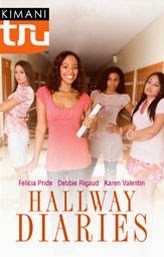
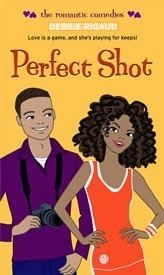
Debbie's books include Perfect Shot and Hallway Diaries, and she has written for Entertainment Weekly, Seventeen, Vibe, Cosmo Girl!, Essence, and other magazines. She lives and writes in Bermuda. Find out more about Debbie and her work here . Come visit me on the Fire Escape!




Published on March 25, 2014 10:28
March 23, 2014
KQED Panel on People of Color in Children's Literature
Excited to be a part of
this
program tomorrow morning on public radio in the Bay Area. Tune in via the web if you're not local—East Coast time 1 o'clock in the afternoon.
People of Color Underrepresented
in Children's BooksMon, Mar 24, 2014 -- 10:00 AM

Getty ImagesEthnic diversity is on the rise in the U.S. So why are children's books still so white? Only about 6 percent of kids' books published in 2013 feature characters that are African-American, Latino, Asian or Native American. We take up the discussion with authors, illustrators and librarians. Does the ethnicity of characters in children's books matter to you?Host: Mina KimGuests:Kathleen Horning, director of the Cooperative Children's Book Center at the University of Wisconsin-Madison's School of EducationLeUyen Pham, illustrator of children's books including "Grace for President," "Freckleface Strawberry" and "Alvin Ho: Allergic to Camping, Hiking, and Other Natural Disasters"Mitali Perkins, children's book author of "Rickshaw Girl," "Monsoon Summer" and "The Not-So-Star-Spangled Life of Sunita Sen"Nina Lindsay, supervising librarian for children's services at the Oakland Public Library, former judge on the Newbery Award selection committee and co-author of the mock Newbery Award blog, "Heavy Medal"Come visit me on the Fire Escape!




People of Color Underrepresented
in Children's BooksMon, Mar 24, 2014 -- 10:00 AM

Getty ImagesEthnic diversity is on the rise in the U.S. So why are children's books still so white? Only about 6 percent of kids' books published in 2013 feature characters that are African-American, Latino, Asian or Native American. We take up the discussion with authors, illustrators and librarians. Does the ethnicity of characters in children's books matter to you?Host: Mina KimGuests:Kathleen Horning, director of the Cooperative Children's Book Center at the University of Wisconsin-Madison's School of EducationLeUyen Pham, illustrator of children's books including "Grace for President," "Freckleface Strawberry" and "Alvin Ho: Allergic to Camping, Hiking, and Other Natural Disasters"Mitali Perkins, children's book author of "Rickshaw Girl," "Monsoon Summer" and "The Not-So-Star-Spangled Life of Sunita Sen"Nina Lindsay, supervising librarian for children's services at the Oakland Public Library, former judge on the Newbery Award selection committee and co-author of the mock Newbery Award blog, "Heavy Medal"Come visit me on the Fire Escape!




Published on March 23, 2014 12:58
March 20, 2014
Introducing OPEN MIC Contributor Olugbemisola Rhuday-Perkovich
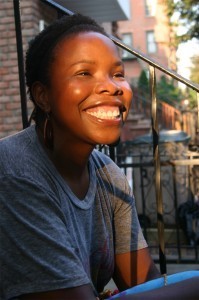 I'm proud to showcase the nine authors who collaborated with me on
OPEN MIC: RIFFS ON LIFE BETWEEN CULTURES IN TEN VOICES
(an anthology published by Candlewick Press). Today's spotlight is on writer Olugbemisola Rhuday-Perkovich (sometimes known as Gbemi.) Publishers Weekly had this to say about our book and, more specifically, about Gbemi's contribution:
I'm proud to showcase the nine authors who collaborated with me on
OPEN MIC: RIFFS ON LIFE BETWEEN CULTURES IN TEN VOICES
(an anthology published by Candlewick Press). Today's spotlight is on writer Olugbemisola Rhuday-Perkovich (sometimes known as Gbemi.) Publishers Weekly had this to say about our book and, more specifically, about Gbemi's contribution:"... Ten writers and artists, including Varian Johnson, Naomi Shihab Nye, and Francisco X. Stork, offer brief works of fiction and nonfiction “about the between-cultures life.” As Perkins notes, “Humor has the power to break down barriers and draw us together across borders,” and the stories within bear that out... Most offer a subtler, uncomfortable brand of situational humor: Olugbemisola Rhuday-Perkovich calls her high school 'an oasis of suburban racial integration'; when the drama club performed The Crucible, 'the drama coach was sensitive enough to ask the black members of the troupe if we’d be uncomfortable playing the role of slave Tituba.' ..."Here are the opening lines from "Confessions of a Black Geek," her memoir in OPEN MIC.
... In high school, my friends and I owned two words—we were Black, and we were geeks. We had the soundtrack to prove the first: classic Nina Simone and Aretha Franklin renditions of "Young, Gifted, and Black." That song was as much a part of my regular diet as the lumpy and not-sweet-enough porridge I had for breakfast many mornings. My mom was an Excellence for Black Children mother, which meant that she battled for Parent-of-a-High-Achiever supremacy at monthly meetings and was quick to whip out the dashiki and boom box so that I could dance interpretively alongside my equally gifted and well-mothered friends at the annual Martin Luther King Jr. breakfasts ...
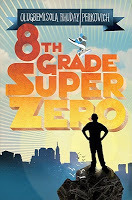 Don't you want to keep reading? Find out more about Gbemi's award-winning novel
8th Grade Superzero
, which was named a Notable Children’s Book for a Global Society and a Notable Social Studies Trade Book for Young People. You may also eavesdrop on a
chat
between the two of us here on the Fire Escape. "I was the new kid at school many times over, in more than one country," says Gbemi. "I now live with my family in Brooklyn, where I write, make things, and need more sleep."Come visit me on the Fire Escape!
Don't you want to keep reading? Find out more about Gbemi's award-winning novel
8th Grade Superzero
, which was named a Notable Children’s Book for a Global Society and a Notable Social Studies Trade Book for Young People. You may also eavesdrop on a
chat
between the two of us here on the Fire Escape. "I was the new kid at school many times over, in more than one country," says Gbemi. "I now live with my family in Brooklyn, where I write, make things, and need more sleep."Come visit me on the Fire Escape!



Published on March 20, 2014 10:51
March 18, 2014
Dimming the Lights ... For a Bit
I'm taking a bit of a break from social media for the purposes of soul care, but I'll return in a few weeks. In the meantime, I'll still be popping out to the Fire Escape every now and then. Thanks, friends.Come visit me on the Fire Escape!








Published on March 18, 2014 14:22
March 17, 2014
Introducing OPEN MIC Contributor Naomi Shihab Nye
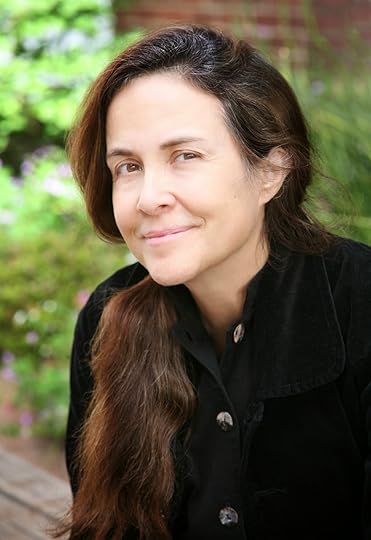 I'm proud to showcase the nine authors who collaborated with me on
OPEN MIC: RIFFS ON LIFE BETWEEN CULTURES IN TEN VOICES
(an anthology published by Candlewick Press). The Horn Book had this to say about our book:
I'm proud to showcase the nine authors who collaborated with me on
OPEN MIC: RIFFS ON LIFE BETWEEN CULTURES IN TEN VOICES
(an anthology published by Candlewick Press). The Horn Book had this to say about our book:"... In her preface to this nicely compact collection, Perkins suggests that humor can help smooth the way in discussions about race — if it’s used carefully, laughing with, not at ... Naomi Shihab Nye offers an eloquent poem about her Arab American dad, whose open friendliness made him 'Facebook before it existed.' ..."It is always a delight to share that the brilliant, award-winning poet Naomi Shihab Nye is a contributor. Here are a few lines from "Lexicon," an original OPEN MIC poem, that illustrate her ability to "combine transcendent liveliness and sparkle along with warmth and human insight," as the poet William Stafford once said:
... Remembering my father's daily sweetness,
the way some people make you better
just by stepping into a room.
He loved the freshness of anything—
crisp cucumbers, the swell of a new day.
The way skin feels after being washed.
I'm happy to see you!
The day just got happier ...
Naomi's award-winning books for children include Habibi, Sitti's Secrets, 19 Varieties of Gazelle, and the forthcoming The Turtle of Oman (HarperCollins, August 2014). I can't wait to read this newest novel.
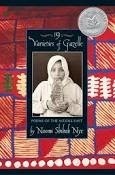

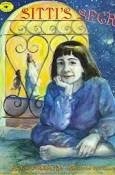
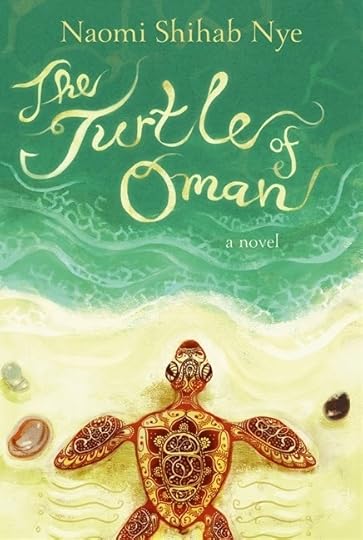
Naomi's father was a Palestinian refugee, and she grew up in Jerusalem and San Antonio, Texas, where she still lives and works. "Writing is the great friend that never moves away," she says. Find out more about Naomi and her work at the Steven Barclay Agency .
Come visit me on the Fire Escape!




Published on March 17, 2014 10:49
February 8, 2014
"Casual Diversity" Depends on the Unseen Work of the Author
Librarian and blogger Betsy Bird recently
issued
a call for books featuring "casual diversity," or a list of children’s books in which "diversity is just a part of everyday life." Here's my two cents:




Even (perhaps especially) in such “real world” books featuring characters with different ethnic backgrounds, the author and/or illustrator should think through carefully how that heritage would shape each character. Perhaps none of that background work that has informed the author’s imagination will be obvious to the reader in the final story or art, but our reflection, personal experience, and research will all affect the characters' depictions–and the child reader–in subtle ways.Throwing in a character of color here or there to make your book more multicultural isn't a shortcut to representing all kinds of children in the real world. As authors and illustrators, the onus is on us to do the unseen work of listening, learning, and understanding, especially because we write for children. What is "under the waterline" in us is bound to be revealed in our stories, and will inform what is "under the waterline" in our child readers. Come visit me on the Fire Escape!




Published on February 08, 2014 18:21
January 29, 2014
In Which ALA Booklist Features A Chat With Me
I'm grateful to the American Library Association's
Booklist
and Dr. Amina Chaudhri for featuring me and my books in the January 2014 issue, with Common Core connections.
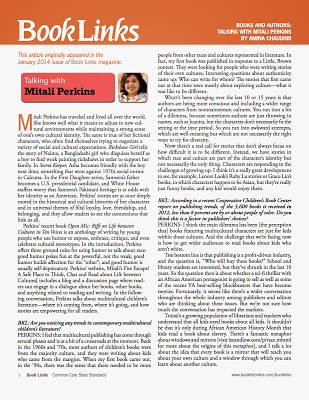 Come visit me on the Fire Escape!
Come visit me on the Fire Escape!




 Come visit me on the Fire Escape!
Come visit me on the Fire Escape!



Published on January 29, 2014 19:34
January 28, 2014
Do We Need "Bridge" Characters in Global Books for Kids?
When challenged by others as to why he focuses on stories about foreigners working in African countries, New York Times columnist Nicholas D. Kristof responds with the idea that "bridge" characters are needed to draw readers into a story.
Post by The New York Times.
The rules must be different in the world of global children's literature. Kristof makes two assumptions that don't work for me: (1) that readers won't be able to connect with stories unless you include an American, and (2) that his readers are American.
In three of my four books set overseas (Secret Keeper, Rickshaw Girl and Bamboo People), I didn't include "bridge" foreigners. Why? I trust young readers to connect with characters of a different culture. And since I grew up "between cultures," I never assume that my reader is staunchly in the majority culture. I like to ask how the story would be received by a child within that culture as well as by North American readers, and "outside saviors" seem to discourage rather than empower non-majority children.
Of course, this literary premise of needing "bridge" characters may be the reason why (a) global books don't sell well without a big gatekeeper push, and (b) I got rejected for years and years because I was submitting books without them.
What do you think? Does a "bridge" character in fiction draw you into a story? If books by authors like Jhumpa Lahiri and Khaled Hosseini didn't have anything or anybody "American" in them, would they have won such wide cultural favor?
And who qualifies to be a bridge? In my novel Monsoon Summer, for example, Jazz is a biracial teen who goes back to India, and we see Pune through her eyes (thanks, John Bell , for reminding me of this.) With an Indian mother and a white American father, is she American enough to serve as a bridge character for American readers?Come visit me on the Fire Escape!




Post by The New York Times.
The rules must be different in the world of global children's literature. Kristof makes two assumptions that don't work for me: (1) that readers won't be able to connect with stories unless you include an American, and (2) that his readers are American.
In three of my four books set overseas (Secret Keeper, Rickshaw Girl and Bamboo People), I didn't include "bridge" foreigners. Why? I trust young readers to connect with characters of a different culture. And since I grew up "between cultures," I never assume that my reader is staunchly in the majority culture. I like to ask how the story would be received by a child within that culture as well as by North American readers, and "outside saviors" seem to discourage rather than empower non-majority children.
Of course, this literary premise of needing "bridge" characters may be the reason why (a) global books don't sell well without a big gatekeeper push, and (b) I got rejected for years and years because I was submitting books without them.
What do you think? Does a "bridge" character in fiction draw you into a story? If books by authors like Jhumpa Lahiri and Khaled Hosseini didn't have anything or anybody "American" in them, would they have won such wide cultural favor?
And who qualifies to be a bridge? In my novel Monsoon Summer, for example, Jazz is a biracial teen who goes back to India, and we see Pune through her eyes (thanks, John Bell , for reminding me of this.) With an Indian mother and a white American father, is she American enough to serve as a bridge character for American readers?Come visit me on the Fire Escape!




Published on January 28, 2014 17:27
January 27, 2014
Help My Class Answer Four Questions From The Margins About Book Awards
Today in my "Race, Culture, and Power in Children's Stories" class at Saint Mary's College of California, we took a look at the winners of the 2014 ALA Youth Media Award. We began to ask four questions:
Do any of the winning books or honorees feature a main character belonging to a group that has endured oppression in North America due to race or culture?Are any of the winning books or honorees set in a non-Western country?Are any of the main characters from an economically powerless family or subculture?Did any of the winning authors/illustrators grow up on the margins of power when it comes to race, culture, and/or class?Setting aside the Coretta Scott King and Pura Belpré awards for a moment, can you help us answer these questions?
Note #1: In my author hat, I'm thrilled for all of the winners and so proud to see children's books making headlines. Congratulations, one and all! But in teacher mode, I am encouraging a focus on marginalized and powerless children and so invite you to join the discussion.
Note #2: If you're curious why some ethnic book awards like the American Indian Library Association's awards weren't on the ALA's official press release or on the main awards page, librarian Edith Campbell provides an explanation and a roundup of the winners.Come visit me on the Fire Escape!




Do any of the winning books or honorees feature a main character belonging to a group that has endured oppression in North America due to race or culture?Are any of the winning books or honorees set in a non-Western country?Are any of the main characters from an economically powerless family or subculture?Did any of the winning authors/illustrators grow up on the margins of power when it comes to race, culture, and/or class?Setting aside the Coretta Scott King and Pura Belpré awards for a moment, can you help us answer these questions?
Note #1: In my author hat, I'm thrilled for all of the winners and so proud to see children's books making headlines. Congratulations, one and all! But in teacher mode, I am encouraging a focus on marginalized and powerless children and so invite you to join the discussion.
Note #2: If you're curious why some ethnic book awards like the American Indian Library Association's awards weren't on the ALA's official press release or on the main awards page, librarian Edith Campbell provides an explanation and a roundup of the winners.Come visit me on the Fire Escape!




Published on January 27, 2014 20:31
Book Awards: Four Questions From The Margins
Today in my "Race, Culture, and Power in Children's Stories" class at Saint Mary's College of California, we took a look at the winners of the 2014 ALA Youth Media Award, announced early this morning. We explored four questions:
Do any of the winning books or honorees feature a main character belonging to a group that has endured oppression in North America due to race or culture? Are any of the winning books or honorees set in a non-Western country?Are any of the main characters from an economically powerless family or subculture?Did any of the winning authors/illustrators grow up on the margins of power when it comes to race, culture, and/or class?Do these questions matter in children's stories? Setting aside the Coretta Scott King and Pura Belpré awards for a moment, how would you answer these questions?
Note: In my author hat, I'm thrilled for all of the winners and so proud to see children's books making headlines. Congratulations, one and all! But in teacher mode, I am encouraging a focus on marginalized and powerless children and so invite you to join the discussion.Come visit me on the Fire Escape!




Do any of the winning books or honorees feature a main character belonging to a group that has endured oppression in North America due to race or culture? Are any of the winning books or honorees set in a non-Western country?Are any of the main characters from an economically powerless family or subculture?Did any of the winning authors/illustrators grow up on the margins of power when it comes to race, culture, and/or class?Do these questions matter in children's stories? Setting aside the Coretta Scott King and Pura Belpré awards for a moment, how would you answer these questions?
Note: In my author hat, I'm thrilled for all of the winners and so proud to see children's books making headlines. Congratulations, one and all! But in teacher mode, I am encouraging a focus on marginalized and powerless children and so invite you to join the discussion.Come visit me on the Fire Escape!




Published on January 27, 2014 20:31



